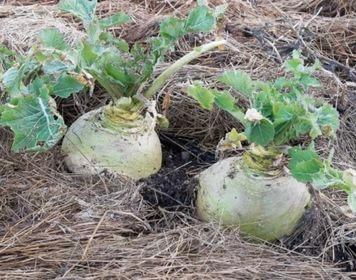Official State Vegetable of Vermont
As delicious as the turnip is, not many turnips have been lucky enough to enter into the annals of human culture—after all, how many different turnips can you name?
The exception to this obscure turnip tale is the Gilfeather turnip, the state vegetable of Vermont. The Gilfeather turnip is both tasty and nutritious, being a delicious addition to various recipes and promoting healthy bodily functions like blood circulation.
What Is the Gilfeather Turnip?
The Gilfeather turnip is not your ordinary root vegetable. Despite its name, it’s a hybrid between a rutabaga and a turnip.
Like most turnips, the Gilfteather turnip’s interior is white and it has a sweet, creamy flavor. This makes it an excellent addition to a wide number of dishes. It can be mashed and mixed with cheese for a creamy delight, substituted for potatoes in some delicious latkes, and made into the base of excellent soups.
Technically, there is some dispute over whether the Gilfeather turnip is a true turnip or rutabaga—but the ambiguity hasn’t degraded the turnip’s popularity in the slightest.
What’s the History of the Gilfeather Turnip?
In addition to the Gilfeather turnip’s scrumptious taste, it has one of the most interesting histories in the turnip world (which, as everyone knows, is quite storied).
The turnip was first cultivated by Vermonter John Gilfeather (the root’s namesake) in the early twentieth century. There’s some debate over whether Gilfeather developed or discovered the turnip, but local Wardsboro scholars theorize that he created the hybrid himself.
Gilfeather, evidently knowing the turnip’s delicious powers, was eager to protect the secret of its growth. As the story goes, Gilfeather was so jealous of his secret root that he shaved the roots and cut off the tops of the turnips before he sold them so that nobody else could grow them. If you think that’s an easy effort, think again—he had to do this to thousands of individual turnips.
Between the turnip’s deliciousness and Gilfeather’s zeal to keep them under wraps, the Gilfeather turnip ended up an immensely successful vegetable while not becoming too widespread. It traveled through markets in Vermont, New York, and New Hampshire, but it remained rare.
However, the end of this story is an unequivocal triumph from the turnip-loving world. In another entry into the mysteries of the vegetable world, the seeds survived. Nobody knows whether the seeds escaped from John Gilfeather’s grasp through malfeasance or charity, but what’s certain is that the heroic Clifford Emery, Gilfeather’s neighbor, gave a jar of the seeds to William and Mary Lou Schmidt in the 1970s.
In turn, the Schmidts led the charge in preserving the seeds, getting the plant categorized as an heirloom crop.
How Did the Gilfeather Turnip Become the State Vegetable of Vermont?
Since the Schmidts preserved the turnip, it became a cherished item in Wardsboro, which hosts regular festivals in honor of the Gilfeather turnip. The annual Gilfeather Turnip Festival is an extravagant bacchanal that is the gem of the turnip-loving war. And what’s better, it benefits the Wardsboro Public Library!
After decades of such appreciation, to the joy of vegetable lovers everywhere, the Gilfeather turnip reached the Mount Olympus of vegetables. After extensive lobbying by the students and faculty of Wardsboro Elementary School, Vermont Governor Peter Shumlin signed a decree in 2016 designating the Gilfeather turnip the state vegetable of Vermont.
There’s ample reason why: unlike many other state vegetables, the Gilfeather turnip is unique to Vermont (contrast this with the delicious but all-too-common sweet potato, which is the state vegetable of four different states). Gilfeather’s farm is still in existence—you can’t get more homegrown than that!
What Are the Health Benefits of the Gilfeather Turnip?
To add to the myth of the Gilfeather turnip, the vegetable is stunningly healthy! One of the key reasons the Vermont legislature adopted the Gilfeather as the state vegetable was its health benefits: it’s an excellent source of potassium, calcium, Vitamin A, Vitamin K, and beta carotene.
Potassium, for its part, is an essential nutrient for blood pressure, water retention, digestion, and muscle health. Calcium, famously, is excellent for bone health. Vitamin A bolsters your eyesight and skin health. Beta carotene, a source of Vitamin A, has the additional benefit of enhancing your immune system. And Vitamin K, a rare but essential nutrient, is stellar for blood circulation.
Healthy Recipe for Gilfeather Turnip Soup
Whether you’re trying to sneak some vegetables into your children’s meals or simply want something warm and comforting on a chilly spring night, Gilfeather turnip soup is a staple in any kitchen.
Ingredients
- 5 Gilfeather turnips
- 2 TBSP butter
- 1 small white or yellow onion, diced
- 4 C broth (chicken or vegetable)
- 2 medium carrots
- 1 sprig of fresh rosemary
- 2 TSP thyme
- Salt and pepper to taste
Method
Start by peeling and dicing your turnips and carrots. Add the butter to your pan on the stove, then add your root vegetables on medium heat. Once things have started to brown and soften, add your onion.
Once the onion has become translucent, add your spices. Allow the spices to saute with the vegetables for two or three minutes, then add the broth and bring everything to a boil.
When the biggest turnips are soft to a fork, you can puree the soup with an immersion blender. Voila! You’re done! For an extra kick, you can add a dollop of sour cream or a sprinkle of cheese to your bowl.
Article provided by Fay Smith. Fay is a mother and an advocate of all things natural. She is regular contributor for several websites.

